A History of the County of Buckingham: Volume 2. Originally published by Victoria County History, London, 1908.
This free content was digitised by double rekeying. All rights reserved.
'Parishes: Princes Risborough', in A History of the County of Buckingham: Volume 2, ed. William Page( London, 1908), British History Online https://prod.british-history.ac.uk/vch/bucks/vol2/pp260-267 [accessed 15 January 2025].
'Parishes: Princes Risborough', in A History of the County of Buckingham: Volume 2. Edited by William Page( London, 1908), British History Online, accessed January 15, 2025, https://prod.british-history.ac.uk/vch/bucks/vol2/pp260-267.
"Parishes: Princes Risborough". A History of the County of Buckingham: Volume 2. Ed. William Page(London, 1908), , British History Online. Web. 15 January 2025. https://prod.british-history.ac.uk/vch/bucks/vol2/pp260-267.
In this section
PRINCES RISBOROUGH
Riseberge (xi cent.); Magna Risberge (xiii cent.); Earls Rysebergh (xiv cent.); Princes Risburgh (xv cent.).
The parish of Princes Risborough lies on the western side of the county of Buckingham. It contains 3,936¼ acres, the greater part, viz. 2,620 acres, being arable land. (fn. 1) There are 1,276¼ acres laid down in permanent grass, and 40 acres of wood. The subsoil is chalk, (fn. 2) but the surface soil is variable; on the hills it is generally light and chalky, and in the lowlands either loam or strong clay. The parish lies on the north-western slope of the Chiltern Hills, rising to over 770 ft. above the Ordnance datum.
The occupation of the people is almost entirely agricultural. There is an iron-foundry at the hamlet of Looseley Row, and sequin and bead-work is done by women at Lacey Green. Water-cress beds exist near the town of Princes Risborough, where there are several springs. Princes Risborough is a small market town, lying 8¾ miles south of Aylesbury on the high road from Aylesbury to Wycombe. The road from Wycombe to Thame branches off to the north-west at the northern end of the town, and the Upper Icknield Way also crosses the parish. The Wycombe branch of the Great Western Railway runs to the west of the town, the station being about three-quarters of a mile away. In 1906 the Great Central Railway opened a branch line to Aylesbury in conjunction with the Great Western Railway, and this line passes through Princes Risborough Station. The centre of the town is at the junction of the three main streets, where the square, red-brick market-house stands, with open arcades and a covered walk on its lower story, and a wooden cupola containing a bell rising from its low slate roof. There are a good many 18th-century red-brick fronts, and near the market-house a gabled half-timber house with herringbone brick filling and a fine central chimney stack. The church is at the north-west corner of the town, standing in a large churchyard, and to the east of it is the manor-house, with remains of two sides of a deep moat in its grounds.
The manor-house is a handsome red-brick building with pilasters and mouldings in cut and rubbed brick. It appears to date from the beginning of the 18th century, but its staircase and the panelling of the drawing-room are some fifty years earlier, and may have been removed from an older building on the same site. They fit so well into their present position that it seems as if the house must have been built with a view to receiving them. The staircase is of oak with a heavy moulded hand-rail and a balustrade of scrollwork, and large square newels with ball finials and moulded pendants. The drawing-room panelling is in two ranges with tall arched upper panels, with small moulded key blocks. Above is a frieze and an elaborate cornice of many moulded members. The mantel is part of the general design, and is enriched with a small Tuscan order, a central oval panel, and flat baluster pilasters below the mantel-shelf. At the window recesses are pilasters reaching from floor to ceiling, the proportions, workmanship, and design being extremely good, and though comparatively plain, the room is a charming example of its date. The entrance hall is also panelled, but not so elaborately, and is probably of the same date as the house. The windows throughout are sashed, and have heavy glazing bars.
Henry VIII made a grant to the inhabitants of Princes Risborough in 1523 of a weekly market and two yearly fairs. (fn. 3) The market was held on Wednesdays, and the fairs for three days at the Feast of the Nativity of the Blessed Virgin, and on St. George's Day. The market day in 1792 had been changed to Saturday, and again in 1888 to Thursday. In 1792 there was only one fair held, on 6 May. (fn. 4) A second fair has since been revived and is now held on 21 October.
The town obtained a charter from Queen Elizabeth in 1598, granting to the inhabitants immunity from serving on juries and paying tolls. (fn. 5) The ancient earthwork called Grim's Dyke enters the parish on the north-eastern border by Lilly-bottom Farm, and reaches to Lacey Green. To the west of the churchyard of Princes Risborough there is a site of about an acre surrounded by a moat that popular tradition asserts to be the site of the Black Prince's palace. The civil parish of Princes Risborough contains the hamlets of Longwick, Lacey Green, Looseley Row, and Speen.
Manors
Before the Norman Conquest PRINCES RISBOROUGH belonged to King Harold. (fn. 6) There was attached to the manor in his time a burgess of Oxford, who remained there after the Norman Conquest, and a salt-worker of Droitwich paid an unspecified number of loads of salt to the lord of the manor in 1086. (fn. 7)
William the Conqueror kept the greater part of Harold's lands, and so Princes Risborough became part of the ancient demesne of the Crown. Half of this part of Risborough seems, however, to have been granted to Ansculf de Pinchengi very shortly after the settlement of the Normans, (fn. 8) but was exchanged for part of Ellesborough with Ralph Talgebosch or Taillebois, by the king's command. Soon afterwards Risborough again changed hands, and was held by the second Earl Walter Giffard, who made various grants from these lands to the abbey of Notley. (fn. 9) From 1162 to 1180 Princes Risborough is said to belong to the honour of Giffard, (fn. 10) but on the death of the earl in 1164 it reverted to the Crown, (fn. 11) and does not appear to have been included in the grant of his honour made by Richard I to William Marshal and Gilbert de Clare, the heirs of the Giffards. Before 1165 the manor was granted to Richard die Humeto, (fn. 12) the Constable of Normandy, and from this time was reckoned among the 'lands of the Normans.' The original grant was probably made by Walter Giffard, but in 1173–4, after his death, Henry II gave a new charter (fn. 13) to the constable. This grant was renewed on Richard's death to his son and successor, William de Humeto. (fn. 14) The latter does not appear, however, to have held the manor, which went to his younger brother Engelard, (fn. 15) but by what charter or right he held it is doubtful. Engelard's son, named William de Similly, (fn. 16) succeeded him, and held the manor till his death, circa 1205, when it escheated to the king. (fn. 17) While in the royal hands, various grants of land (fn. 18) in Risborough were made, but only of a temporary nature, and by 1224 (fn. 19) William de Similly's son, another William, was in seisin of the manor. The heirs of Earl Giffard (fn. 20) now made a determined attempt to recover Princes Risborough, claiming that it was part of the honour to which they had succeeded. Moreover, they denied that William de Similly could claim from the grant to the Constable of Normandy, as that grant had been made to Richard de Humeto and his heirs, and William was not his heir. No result came of their suit, since it was decided that the question must stand over till the king was of age. A second suit (fn. 21) was subsequently brought by Gilbert, Earl of Gloucester, against William de Similly, but the result is not recorded. The latter, (fn. 22) however, remained in peaceful seisin of the manor (fn. 23) till his death before 1242. (fn. 24) The land then escheated to the king, the heir being a minor, and the rights of wardship were granted to Drogo de Trubleville. (fn. 25) The heir of William de Similly is never mentioned again, and presumably died before coming of age, for in 1243 Henry III granted the manor of Princes Risborough to Richard, Earl of Cornwall and King of the Romans. (fn. 26) Richard was succeeded by his son Edmund, Earl of Cornwall, (fn. 27) who held the manor till his death in 1300, (fn. 28) when it again came into the king's hands, Edward I being the next heir. The king held it in demesne in 1302–3, (fn. 29) but immediately afterwards he granted it to Queen Margaret for life, in exchange for certain castles and lands with which he had dowered her. (fn. 30) Margaret, the Countess of Cornwall, however, held a third as part of her widow's dower during her life. (fn. 31) The reversion was granted in 1309 to Piers Gaveston and his wife Margaret, (fn. 32) one of the heiresses of the Clares, and also one of the descendants of the Giffards, but this grant was surrendered in the same year. (fn. 33) Queen Margaret lived till 1316, (fn. 34) and from the time of her death till 1327 the manor of Princes Risborough was held by the king. (fn. 35) At the latter date Edward III granted it to Queen Isabella in reward for her services with regard to the treaty with France and the suppression of the Despensers' Rebellion. (fn. 36) In 1330 John de Eltham, Earl of Cornwall and brother of the king, obtained a grant of the manor of Risborough, (fn. 37) but after his death in 1337 (fn. 38) Queen Isabella again held the manor. The reversion was granted to Henry de Ferrers, (fn. 39) who obtained possession after the death of Isabella, and died seised in 1344. (fn. 40) His son was a minor, and the custody of the manor was granted to the Black Prince, (fn. 41) from whom it took its present name of Princes Risborough. (fn. 42) The prince (fn. 43) held the manor till his death, when it passed to Richard his son and heir. (fn. 44) The latter, while still prince, granted the manor for life to Lewis de Clifford. (fn. 45) He confirmed the grant on his accession to the throne, and Lewis held it for his life. Under Henry IV the manor came into the hands of the Crown, and was again granted to the Prince of Wales. (fn. 46) Henry VI succeeded to the manor, (fn. 47) which formed part of the dower of his queen, Margaret of Anjou. (fn. 48) Afterwards, however, it seems to have been held by his son Edward, Prince of Wales. (fn. 49) It remained in the hands of the Crown apparently till Edward VI granted the manor to Princess Elizabeth for life. (fn. 50) James I granted it to Anne of Denmark as part of her dower, (fn. 51) and on her death to Sir Henry Hobart to the use of Prince Charles. (fn. 52) In 1628 Charles I conveyed the manor to the City of London in part payment of the large debts of the king. (fn. 53) The fee-farm rent from the manor (fn. 54) was granted in 1671 to Lord Hawley in trust for the king's heirs and successors, (fn. 55) until it was sold. This sale took place in the same year to Sir Peter Lely, (fn. 56) the painter. Under the Commonwealth the manor of Princes Risborough, distinguished at this time as the King's Manor, (fn. 57) came into the hands of Ralph Adeane. (fn. 58) He held it in 1653 (fn. 59) and 1655, (fn. 60) and after the Restoration Thomas Adeane, a minor, was lord of the manor as heir of Ralph. (fn. 61) In 1684, however, Edward Bigland and George Pelham appear to have been in seisin. (fn. 62) In 1702 and in 1729 Henry Penton held this manor (fn. 63) In 1766 it was sold by the Penton family to John Grubbe of Horsenden. (fn. 64) In the same year he, together with his next brother Samuel, sold it to Edward, the third brother. (fn. 65) Edward's grandson John held the manor in 1813, (fn. 66) but in 1841 it was advertised for sale by auction. (fn. 67) It was, however, purchased privately by the Duke of Buckingham and Chandos on the day previous to the sale. (fn. 68) The duke's lands were sold very shortly after the purchase of this manor, which, in 1862, was in the hands of Mr. James Cuddon (fn. 69) At the present day Mr. Humphrey Brill, of Aston Clinton, claims to be lord of the manor of Princes Risborough.

Princes Risborough: Church Street

Cornwall. Argent a lion gules crowned or in a border sable bezanty.

England. Gules three leopards or.
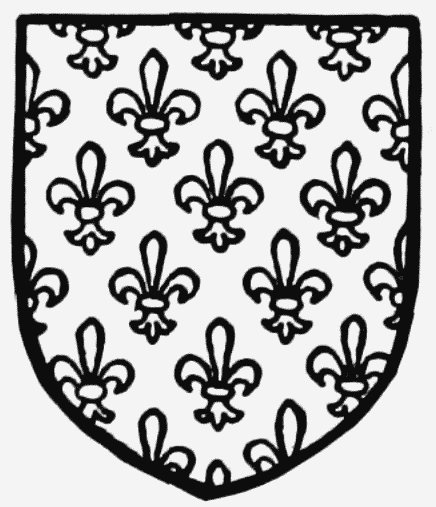
Old France. Azure powdered with fleurs-delis or.
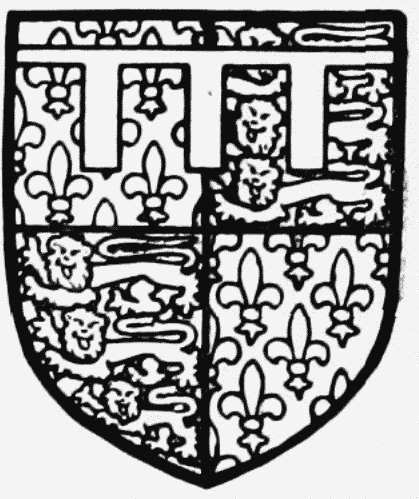
The Black Prince. Old France quartered with England, a label argent for difference.
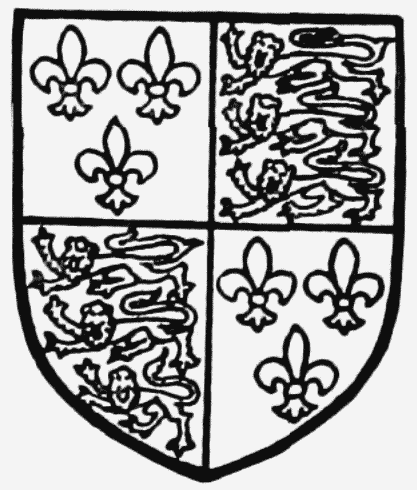
England. France quartered with England.
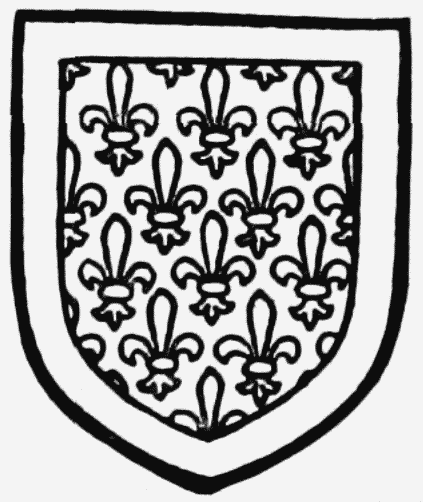
Anjou. Old France in a border gules.
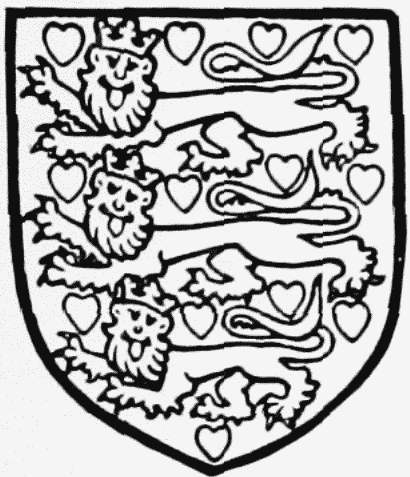
Denmark. Or powdered with hearts gules three leopards azure with golden crowns.
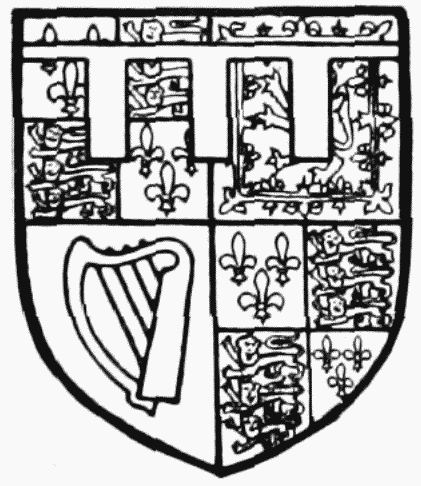
Charles, Prince of Wales. The royal arms of the Stuarts, France and England quartered with Scotland and Ireland, with the difference of a label argent.
This manor in Princes Risborough was held by William de Similly by the service due from one knight's fee, (fn. 70) and the same service was performed by the Earls of Cornwall. (fn. 71) In later grants the service is not defined. The lords of the manor under the Commonwealth paid a fee-farm rent, which in 1671 was given as £82 4s. 7½d. (fn. 72) It is interesting to note that this rent had hardly varied from the yearly value of the manor 300 years before. In 1303 it was £82 9s. 3d., (fn. 73) and in 1337 £84, (fn. 74) and 1381 £90. (fn. 75)
Earl Walter Giffard and Countess Ermengarde granted a wood called Lullested in Princes Risborough to the abbey of Notley, on its foundation. (fn. 76) This grant was confirmed by Henry II and John and by Edward III. (fn. 77)
In 1291 the temporalities of the abbey in Princes Risborough were lands and meadows worth 12s. 9d. a year. (fn. 78) The abbey probably obtained further grants of land in the parish, since at the Dissolution it held the manor and rectory of Princes Risborough, valued at £40 a year. (fn. 79) Henry VIII granted this manor, known as the ABBOT'S MANOR, to the dean and chapter of Oxford, (fn. 80) but they forfeited it not long afterwards. Edward VI on his accession to the throne gave it to Robert King, Bishop of Oxford, (fn. 81) but Elizabeth recovered the manor from the bishop in 1589. (fn. 82) In the same year she had already granted it to Thomas Crompton, Robert Wrighte, and Gilley Merick. (fn. 83) Crompton sold it to John Jackman, (fn. 84) who held it at his death in 1622, (fn. 85) when it passed to his son. The latter sold it in 1624 to Joan Chibnall and Vincent Barry, (fn. 86) who was the steward of the King's Manor. (fn. 87) During the Civil War this manor presumably came into the hands of Ralph Adeane, who certainly had the rectory. (fn. 88) In a suit as to the customs of the manor in 1675, (fn. 89) the King's Manor and the Abbot's Manor are both mentioned; the former is said to belong to the ancient demense of the Crown, and not the latter, but both seem to be held by Thomas Adeane, and from this time continued to be held together.
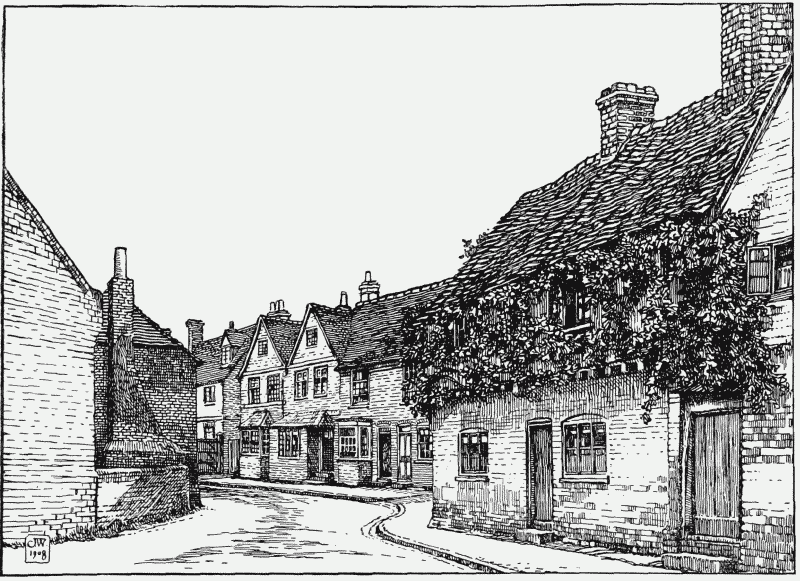
Princes Risborough: Church Street
In Elizabeth's grant to Thomas Crompton, (fn. 90) a mansion-house called 'Broke House' is specially mentioned, and appears in the majority of the deeds relating to the manor. The latter indeed is sometimes called Brooke, the description in 1813 (fn. 91) being the 'manor of Risborough or Princes Risborough or Brooke or Abbot's Risborough commonly called the Abbots' hold.' By Walter Giffard's grant the wood was held by the abbey in frankalmoign, (fn. 92) and the Bishop of Oxford held the manor in the reign of Edward VI on the same tenure, but also paid rent for it. (fn. 93)
CULVERTON is first mentioned in 1247. (fn. 94) Stephen son of Hugh of Culverton then held 1 hide of land of Philip son of Oliver. He had formerly paid the yearly rent of 1 mark, but it was changed by agreement to the payment of a clove gilly-flower yearly. In 1317 Hugh of Culverton made an exchange of land in Princes Risborough with John de Foxle and his wife Constance. Hugh by this settlement was to hold his land and tenements for life, with remainder to John and Constance and the heirs of John. (fn. 95) The other piece of land which changed hands was to be held by John and Constance and the heirs of John. (fn. 96) These arrangements suggest that Constance was possibly the heiress of Hugh de Culverton. John de Foxle died, in 1324–5, seised jointly with his wife of land at Culverton. (fn. 97) Constance then held them alone and presumably was succeeded by Thomas de Foxle. (fn. 98)
In the next century Richard de la Hay held the manor of Culverton, which in 1443 was settled intact on Matthew de la Hay and his wife Anne. (fn. 99) It was sold in 1516–17 by Thomas a Botre and his wife Joan to Robert Bonner. (fn. 100) It had apparently been the inheritance of Joan. (fn. 101) In 1633–4 the manor of Culverton alias Frogmore House passed from Charles Alden and his wife Alice to Ralph Baldwin; (fn. 102) five years later the latter conveyed it to Francis Steevens. (fn. 103) John de Foxle held his land in Culverton of the king in chief, of the manor of Princes Risborough. (fn. 104) He did suit of court at Risborough every three weeks, and paid a yearly rent of 33s. 9d. (fn. 105)
In 1316–17 the king granted him and his heirs the right of free warren in all his demesne lands in Princes Risborough and Saunderton. (fn. 106)
The Park
The manor of Princes Risborough in 1086 was assessed at 30 hides, and of these 20 were then contained in the demesne of the king. (fn. 107) This suggests that even in the 11th century the nucleus of a park already existed, and a few years later the wood of Earl Walter Giffard is mentioned in the foundation charter of Notley Abbey. (fn. 108) The park is mentioned in the inquisition taken at the death of Richard Earl of Cornwall, (fn. 109) and the Abbot of Notley had various rights in it, (fn. 110) to maintain which he was continually making complaints to the king. (fn. 111) Edward II and probably his predecessors used the park of Risborough as a stud-farm. The buildings in the manor were repaired in 1318, (fn. 112) so that the horses of the king's stud could be properly kept there, and a special inclosure was made in which the horses might be exercised. Orders were given that the keeper of the stud should have whatever was required for the horses. (fn. 113) The colts are particularly specified in some of the orders, and in the appointment of William de Framesworth as keeper of the stud it is specially mentioned that he was to have the custody of the colts as well as of the horses already broken in. (fn. 114) The deer in the park are also mentioned in 1337, (fn. 115) when orders were given that thirty-two should be taken from the parks of Risborough and Cippenham, and sent to Westminster for the funeral expenses of John Earl of Cornwall, the king's brother. The park was however, always granted with the manor until Henry VIII granted an inclosure, called Risborough Park, to Sir Edward Don. (fn. 116) The Dons had already held the parkership of Risborough; Edward IV had granted it to Sir John Don, who retained his office after the accession of Henry VII. (fn. 117) In 1520 the office of parker was granted to Sir Edward himself, and to Sir John Daunce in survivorship. (fn. 118) Sir Edward's daughter and heiress Anne married George Cotton of Whittington, (fn. 119) Gloucestershire, and she held the park for her life. (fn. 120) The reversion, to fall in after her death, was sold in 1562 by Edward Daunce to Sir William Dormer. (fn. 121) Robert Lord Dormer, the son of Sir William, died seised of the Risborough Park (fn. 122) in 1617, his heir being his grandson Robert, whose estates were sequestered during the Civil War. (fn. 123) In 1561 George Gosnald, of Colston Basset, Notts., obtained the estate of Lord Dormer in Princes Risborough on a lease, paying £230 a year. (fn. 124) Lord Dormer was said to have held it at a yearly rental of £100. (fn. 125) This estate was not definitely called the Park of Princes Risborough, but it seems probable that it may be identified with it. No mention of the park is made after the Restoration, and it seems to have been recovered by the lords of the manor. When Ralph Adeane held the property in 1653 (fn. 126) there were 800 acres of wood and 60 of furze and heath attached to the manor, the total acreage of land of all kinds being 1,360 acres, and rents being paid further to the value of £15 a year. The Abbot's manor was not included in this.
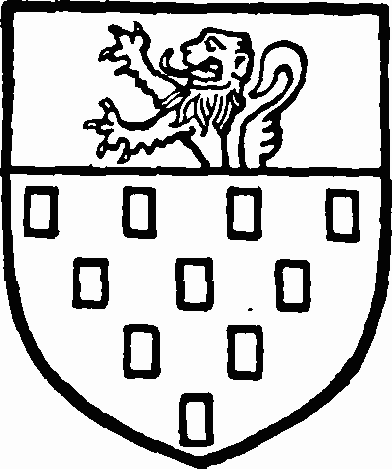
Dormer. Azure ten billets or and a chif or with a demi lion sable.
In the Domesday Book there were two mills at Princes Risborough, worth 14s. 8d. a year. (fn. 127) They may probably be identified with the two water-mills mentioned in the reign of Henry III. Geoffrey Neyrnut held one of these of the King of Almain, then Richard Earl of Cornwall, the lord of the manor, and the second of Richard de la Forde. (fn. 128) One water-mill was held in the 17th century by William Hampden. (fn. 129) It was left under his will to his cousin Richard Hampden. (fn. 130) It was then called Longwick Mill, a name which is still used for the water-mill in the hamlet of Longwick at the present day. A watermill was also held by Robert Lord Dormer, early in the 17th century, (fn. 131) and a water-mill and a windmill are mentioned in 1712, being then in the possession of Charles Dormer. (fn. 132)
In the 14th century there was a water-mill at Culverton. (fn. 133) A mill was first mentioned in the settlement made between Hugh of Culverton and John de Foxle in 1317, (fn. 134) and the latter died seised of a water-mill. (fn. 135) In the conveyances of the manor of Culverton in the 17th century the water-mill passed with the manor. (fn. 136)
Church
The church of OUR LADY consists of a chancel 32 ft. 9 in. by 17 ft. 10 in., with a modern organ chamber on the north; a nave 60 ft. 9 in. by 26 ft. 3 in.; north and south aisles 11 ft. 3 in. and 8 ft. wide respectively; a south porch and a western tower. Up to the first quarter of the 13th century the church consisted of a chancel and an aisleless nave of the same width as at present, but some 10 ft. shorter. About 1220 north and south aisles were added, and about 1300 the nave and aisles were lengthened by one bay, a tower being probably begun at the same time. A little later, in the 14th century, the chancel was rebuilt, and the clearstory was a 15th-century addition. In modern times the church has been drastically restored, few of the windows remaining untouched. The clearstory and north aisle were rebuilt, and the east responds of the nave arcades, which were of some depth, pierced with small arches in continuation of the arcades. In 1907 a new tower and a tall stone spire were begun from the designs of Mr. Oldrid Scott.
The east window of the chancel is modern and of geometrical detail. In the north wall is a muchrestored early 14th-century window of two uncusped lights, with an uncusped circle over and shafts to the internal splay. West of this is the opening to the modern organ chamber. At the south-west of the chancel is a trefoiled piscina, circa 1330, with a shelf and a double drain. The two windows in the south wall, of 14th-century style, and the door between them, are all much restored but in part ancient Below the western window is a blocked low side window, with a square head and plain chamfered jambs and with its iron bars still in position. The chancel arch is modern and of late 13th-century style.
The nave is of seven bays, and the two arcades are practically identical, the arches throughout being of two chamfered orders. The first arch on either side is modern, and also the first column, circular in plan and with moulded capital and base. The second, third, fourth, and fifth columns and arches, and the sixth arch are of 13th-century date, the columns being octagonal and the arches having plain chamfered labels, with moulded capitals and plain bases. The seventh pair of arches, circa 1300, have a filleted roll label, and the sixth columns and the western responds are of the same time and are of quatrefoil plan, with moulded capitals and bases of the same form and date, but varying from each other in the details of moulding. The tower arch is modern and of early 14th-century design. The clearstory has five modern sixfoil circles on either side, and is shown by Lipscomb to have originally had two-light windows in this position. (fn. 137)
The north aisle opens to the organ chamber by a modern arch, and the north wall of the aisle has been completely rebuilt; but in the main with old materials. The windows are four in number, the first two of three trefoiled lights with tracery over, the others of two lights, and all with segmental heads and of 14th-century detail. Some old stones are set in their jambs and splays, but the tracery in all cases is quite modern. The blocked north door in the middle of this aisle is of 14th-century date but very much restored, with continuously moulded jambs and two-centred head of two orders. There is no west window to either aisle.
The south aisle has a much-restored east window of 14th-century date, with two uncusped lights. The shafted jambs, mullion, and splays are old, and have circular moulded capitals and bases. In the south wall, at the east end, are a much-defaced piscina and sedile of 14th-century date, with the remains of elaborate projecting canopies with shafted jambs; in the piscina is a stone shelf. Immediately west of this is a very remarkable three-light window, which looks like 13th-century work reused and altered circa 1320. The lights are uncusped, and have a square inner reveal and stilted moulded rear arches resting on freestanding shafts with octagonal moulded capitals; there are engaged shafts to the tracery orders also. Partly under this window is a 14th-century tomb recess with a sub-cusped cinquefoiled ogee head, and another like it to the west; both are now empty. Close to the south door is a small plain much restored holy water recess, and from this point to the sedile runs a stringcourse on the level of the sill to the window last described. The south door is of late 13th-century date, with a deeply-moulded two-centred head and shafted jambs with circular bases and capitals. West of the south door is a window of three cinquefoiled lights, repaired, but of 14th-century date, and there is a contemporary moulded string-course forming its sill and extending some distance on each side of it. Below are two tomb recesses similar to those already described, but having shafted jambs.
The south porch is modern and has a small lancet on either side.
The new western tower is of three stages, with a tall stone spire, and incorporates the old tower, which has been refaced.
The font is modern, with a plain octagonal bowl. There are no monuments of interest in the church, and the roofs and seating are modern. There is, however, a 17th-century oak pulpit.
There is only one bell, dated 1838, and a small 'ting-tang,' dated 1805.
The church plate consists of a communion cup of 1752, given by Thomas Penn, rector; a plated paten; and a flagon of 1629, given by Miss Mary Chibnall.
The first book of the registers contains baptisms and marriages from 1561 to 1695 and burials from 1561 to 1678. Burials are continued in a second book from 1678 to 1727, and baptisms and marriages in a third from 1695 to 1721. A fourth book contains baptisms and marriages from 1721 to 1754; a fifth and sixth burials from 1721 to 1786 and from 1786 to 1812. Baptisms, after a gap, are continued from 1788 to 1812, and three books containing marriages with banns run from 1754 to 1776, from 1776 to 1803, and from 1803 to 1812.
Advowson
The church of Princes Risborough was granted by Walter Giffard to Notley Abbey (fn. 138) at its foundation, with the tithes of his demesne lands there. A vicarage, however, was not ordained. In 1258 the abbot obtained leave from the pope that the churches and chapels belonging to his abbey should be served by the canons or other priests, who should be answerable to the abbot and convent. (fn. 139) This method of serving the churches caused various complaints in the 14th and 15th centuries, (fn. 140) but the privilege was confirmed by Boniface IX in 1402. (fn. 141) The rectory belonged to the abbey of Notley at the dissolution of the monasteries. (fn. 142) It was afterwards granted by Henry VIII to the Dean and Chapter of Oxford, (fn. 143) and was held with the Abbot's Manor till the 19th century. A vicarage is mentioned in the grants of Henry VIII (fn. 144) and Edward VI, (fn. 145) but this was probably a mistake. The advowson of the church was granted with the rectory to Thomas Crampton, (fn. 146) and the church was served by a perpetual curate appointed by the impropriator of the rectory. The patronage was transferred to the Bishop of Oxford in 1860, (fn. 147) and finally the benefice was declared a rectory in 1868. (fn. 148)
A chapel of St. John the Evangelist was built at Lacey Green early in the 19th century, (fn. 149) the plan being mainly carried through by the exertions of the Rev. Richard Meade, rector of Horsenden and perpetual curate of Princes Risborough. It was consecrated by the Bishop of Lincoln in 1825.
The hamlet, with Looseley Row and Speen, was, however, formed into an ecclesiastical parish in 1851; (fn. 150) the living is a vicarage in the gift of the rector of Princes Risborough.
The Abbot of Notley, at the time of the Dissolution, was bound to distribute certain charities to various poor persons at the church of Princes Risborough, to the value of 20s. a year, for the benefit of the souls of the Earl Walter Giffard and the Countess Ermengarde. (fn. 151) An acre of land was also granted to provide a light at Princes Risborough, presumably within the church. (fn. 152) A Baptist chapel was built in 1707 in Bell Street, and a second chapel was opened at Looseley Row in 1862. There is a branch of the Bell Street chapel at Longwick, where there is also a Wesleyan chapel. The Wesleyan Methodists have a chapel in Princes Risborough, built in 1869. At Speen there is a Baptist chapel opened in 1813, and the Primitive Methodists have a chapel at Lacey Green.
For many years there was an ancient custom at Princes Risborough by which the impropriator gave a bull and a boar on Christmas Day for the use of his parishioners. They were distributed 'in large pieces, smoking hot from the copper at five o'clock in the morning for breakfast on Christmas Day.' (fn. 153) Four bushels of wheat and four bushels of malt were also made into bread and beer and given away. The custom however was given up before 1847. (fn. 154)
Charities
In 1615–16 William Smith by his will left £40 for the use of the poor. The legacy was laid out in land, in respect of which 3 a. 2 r. 36 p. in Near Side Field were allotted on the inclosure in 1820. The land is let in allotments, producing about £7 a year, which is applied in the distribution of money, 2s. 6d. to each recipient.
An annual payment of £32 a year is made by Lord Rothschild out of the Manor Farm, Tring, in respect of Joan Chibnall's Charity, by will, 1646, for providing gowns, &c., for poor widows or ancient ladies of Princes Risborough, and other parishes in this county and Oxford. In 1905 thirteen women of this parish were provided with gowns at a cost of £8; 2s. were given to fifty-one recipients and 10s. paid to the rector for a sermon.
In 1684 Thomas Meade left £100 to be laid out in land, the rents and profits to be applied in apprenticing to trades (except husbandry). The legacy was laid out in the purchase of land, in respect of which at the inclosure in 1820, 3 a. or. 10 p. in Near Side Field were allotted for the poor. The land is let at £3 10s. a year.
In 1713 Mrs. Katherine Pye by deed settled lands in Towersey for educational and eleemosynary purposes in the parishes of Bradenham, Towersey, Princes Risborough, Hughenden, and West Wycombe. The land, known as Quash Farm, contains about fiftythree acres awarded under the Towersey Inclosure Act, 1822, producing a net income of about £60 a year. By an order of the Charity Commissioners, dated 15 March 1904, made under the Board of Education Act, 1899, the part of the endowment applicable for educational purposes was determined to be an annual sum of £36 for schooling certain children of the said parishes, and an annual sum of £1 1s. 8d. for books for such children leaving school. The yearly sum of £12 is payable under the deed of foundation to six poor widows, or widows and maids of Bradenham, Towersey, and West Wycombe, 40s. to each; £5 to the treasurer, and 40s. for the expenses of the trustees, and the surplusage, if any, in apprenticing.
The sum of £8 10s. is received as the share of Princes Risborough, and applied to general school expenses.
In 1772 Richard Stratton by will bequeathed £500 to the governors of Christ's Hospital, to secure the nomination of one poor boy belonging to Princes Risborough.
Elizabeth Eustace, by deed 5 July 1784, gave certain lands for providing 'lots of linen' for the poor. On the inclosure 1 a. o r. 27 p. were allotted in respect thereof, which is let at £4 10s. a year, of which the sum of £1 3s. is paid to the parish of Bledlow. In 1905 linen to the value of 5s. was given to each of twelve recipients, and 1s. was retained by each of the five trustees in pursuance of the provisions of the deed.
The Poor's Land allotted on the inclosure contains 39 a. 3 r. 11 p., let to fifteen tenants at £30 a year. The net proceeds are distributed in coal among the cottagers.
The Church Land consists of 32 p. at Longwick, let at £1 1s. a year, which is applied towards the church expenses.
The Baptist Chapel in Bell Street, erected in 1707, in addition to the Minister's House, is possessed of a house at Parkfield, let at £12 a year. By an order of the Charity Commissioners, dated 11 March 1898, new trustees of the trust property, including the old and new burial-ground, were appointed.
